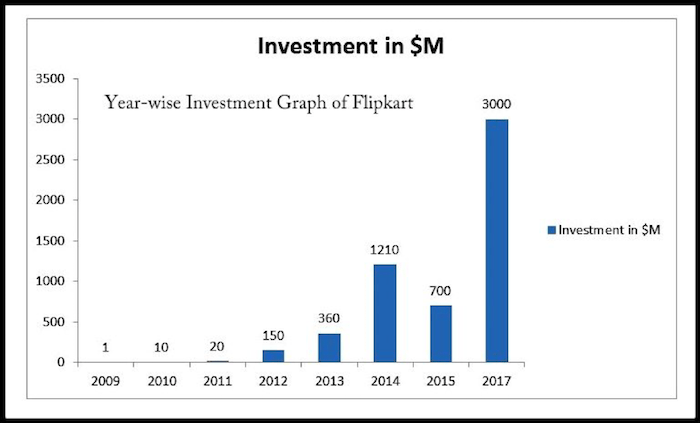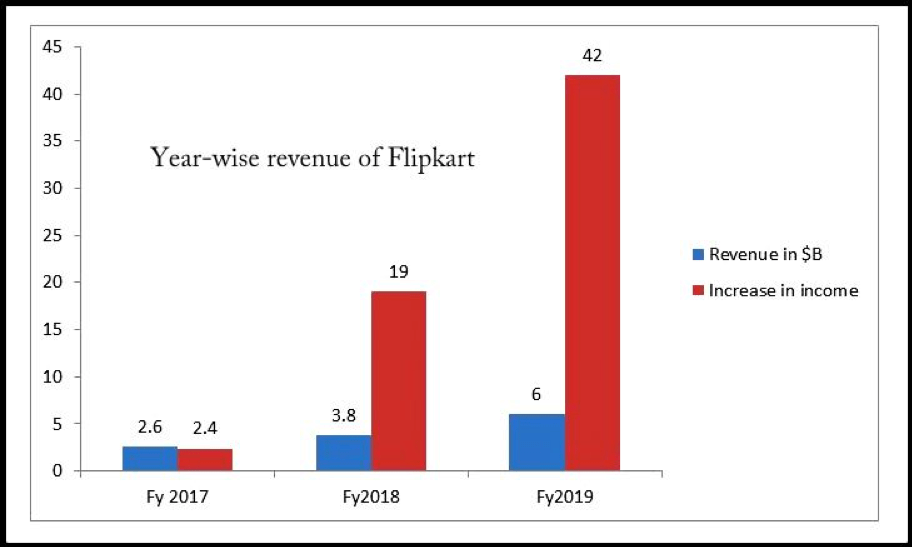What is Flipkart – Founders, Subsidiaries, Funding & Revenue, Walmart Acquisition and more
Flipkart is an online platform where buyers and sellers meet their requirements. The Company is a Bengaluru based e-commerce company, founded in 2007 by Sachin Bansal and Binny Bansal. In 2018, Walmart acquired Flipkart for $16 billion.
Flipkart online shopping app is India’s most-used shopping app with more than 11 million users. The Walmart-owned Flipkart’s revenue was $6 billion in 2019. Flipkart India, which is the wholesale arm of Flipkart, made $4 billion in the same financial year.
The company has a 70% share in the Indian market under the apparel and accessories section. India’s Online Fashion market is expected to grow rapidly in the upcoming future. It acquired Myntra and Phonepe which made the business easier and also added significant growth to Flipkart’s revenue.
Flipkart Subsidiaries
Flipkart has more than half-a-dozen of subsidiaries like Myntra, Jabong, and Phonepe, etc. under its asset list. Let’s discuss more about Flipkart subsidiaries and see how they fuel up the revenue of Flipkart.
- Myntra – Flipkart–Myntra took place in 2014 with a breaking deal of $280 million. Myntra had 30% of the market share in fashion sales, which influenced this purchase. After the merger, Flipkart had 50% of the overall market share and had nearly 100% of annual growth.
- Jabong – Jabong was acquired by Myntra in July 2016 for about $70 million, which indirectly made it a subsidiary of Flipkart. In early 2020, Walmart-owned Flipkart formally shut down Jabong to focus on Myntra.
- Ekart – Ekart is the Logistics arm of Flipkart. Ekart was acquired by Flipkart in 2015 from WS Retail services. But from Feb 5, Ekart no longer operates its customer-to-customer courier service started in 2016. This step was taken to consolidate the logistics of Flipkart.
- Phonepe – Phonepe is an online payment platform, acquired by Flipkart in April 2016. Phonepe is recognized as an independent business unit with over 218 million users. Phonepe is set to raise $10 billion for the current fundraising cycle of the company.
- Jeeves – Jeeves is Flipkart’s branch for after-sales services for large home appliances and electronics. The company acquired the majority of stake in Jeeves in November 2014 to enhance consumer satisfaction. Currently over 300 Jeeves centers are operating across the country.
- 2 GUD – Flipkart launched the 2GUD website to sell refurbished products. Initially, it started with 400 categories of electronic products. Refurbished goods market is expected to grow over $20 billion in upcoming years; this made Flipkart India introduce 2GUD to the existing users.
Walmart-Flipkart Acquisition
Walmart-Flipkart acquisition took place in 2018. The U.S-based retail giant bought 77% stake of the company worth $16 billion. This was the biggest investment in the history of e-commerce sector. Flipkart’s global recognition made a significant growth after that.
Cause of Acquisition
Initially investors were worried about the loss due to acquisition of Flipkart. But Indian e-commerce market is expected to touch $200 billion by 2026, which made Walmart invest in the Indian e-commerce company.
Flipkart, before & after Acquisition
Flipkart started from an online Bookselling platform in 2007 and made subsidiaries like Myntra and Phonepe before its acquisition. After acquisition from Walmart in 2018, its net worth reached up to $21 billion.
Impact of Walmart Flipkart Acquisition
Walmart-Flipkart merger brought job opportunities for the people and was influential for small business growth in India. It gave the company the global exposure to increase its global reach.
Flipkart Funding and Investments
Flipkart’s funding started in 2007 when Bansals invested around US$5500 on-site development. After that its business model was able to attract many small to large investors towards the organization. Following are some of the important investments of the investors in Flipkart till date.
- First investment came from Accel Indian which made $1 million in 2009.
- Tiger Global came up with $10 million in June 2010 and $20 million in 2011.
- Naspers Group’s MIH invested $150 million in August 2012.
- Existing Investors invested $200 million Flipkart got $160 from new investors in 2013
- Existing Investors and Yuri Milner’s DST Global invested $210 in 2014
- Company raised $1B from GIC Singapore and existing backers in 2014
- In 2015, it reached a valuation of $15.5B and rose $700M from existing investors.
- IN 2017, it raised a total of $3B.
- In 2018 Walmart bought a 77% stake of the company at $16B.
Following is the year-wise analysis of Flipkart Funding till the Acquisition.

Flipkart Revenue
The company gets most of its revenue from collection, marketplace, and logistics. A lot happened in a previous couple of years in the company. Due to an edge-to-edge competition from its rival Amazon, its revenue surely hampered.
Let’s try to find more about it’s revenue in previous years with the help of data below.
Flipkart’s revenue in FY 2019
- Flipkart revenue in the financial year ending March 2019 was $6 billion.
- It was a part of Walmart now.
- There was a 42% increase in income as compared to previous year’s income.
Flipkart’s revenue in FY 2018
- Revenue of Flipkart in the financial year ending March 2018 was $3.8 billion dollars.
- There was a 19% increase in income as compared to the previous year’s income.
- This time its wholesale arm was the major part of the revenue.
Flipkart’s revenue in 2017
- Flipkart revenue in the financial year ending March 2017 was $2.6 billion.
- The marketplace was performing badly due to bad Business model.
- There was a 29% increase in income as compared to the previous year’s income.

After multiple acquisitions and a head to head competition from another e-commerce giant, the company saw a dip in the revenue during 2017-18. But after the emergence of Walmart, its revenue growth went up to whopping 42%. As Indian online market is expected to grow rapidly in upcoming years, it looks like the company is sitting on a goldmine.
Flipkart in Global Market
Flipkart is India’s top e-commerce platform. Despite being at the top, it gets a direct competition from its rival Amazon in India. The company holds 38% of market share in India where Amazon plans to invest $1billion per year in its infrastructure in the country.
Let’s look at Flipkart’s position in the global online retail market.
- Walmart-Flipkart the acquisition increased monthly customers to 45% and there is a 30% increase in transactions as well.
- According to the fourth-quarter earnings of 2019, growth in international sales is 2.3%, which is $33 billion.
- Last year was not that good in terms of cash flow, as it went down to $14.5 billion from $17.4 billion of 2018.
It’s position in the global online retail market looks stable. After Walmart acquiring most of the company stakes, sales have seen significant growth in the previous years. Even if the prime focus was to target the Indian online market, company’s global share has shown increment. This is a good sign for the Indian e-Commerce platform.
People behind Flipkart
No organization can become successful without its capable workforce. Flipkart started as a bookselling platform in 2007 and now it’s a big name in the e-commerce industry. The company had many ups and downs like any major organization.
Let’s try to find out more about the people behind Flipkart and see how they helped this organization to reach to the level where it is standing today.
Flipkart Founders
Flipkart founders, Sachin Bansal and Binny Bansal were both alumni of IIT Delhi. They worked for Amazon before starting Flipkart. Due to the same surname they often get mistaken as siblings, which is not the case. They were named as most powerful people of 2017 by India Today.
Ex-Flipkart CEO, Sachin Bansal

Sachin Bansal was born on August 5, 1981, in Chandigarh. He completed his Degree in Computer Science and engineering in 2005 and joined Techspan. After working there for a few months he joined Amazon Web Services as a Senior Software Engineer. He quit Amazon in 2007 to start Flipkart.
In December 2018, Sachin Bansal made an exit from Flipkart and founded BAC Acquisition Private Limited. He held a 5.5% stake in Flipkart, which he sold off to Walmart. At the time of exit, his net worth was $1 billion.
After exiting Flipkart, Bansal decided to work on pending projects and investments in local and early-stage startups. In April 2020, Navi Technologies announced him as its Managing Director.
Ex-Flipkart CEO, Binny Bansal

Co-founder Binny Bansal was born in 1982-83 in Chandigarh, same place as Sachin Bansal. Binny Bansal also had a Computer Science degree in engineering from IIT Delhi. After his graduation he joined Amazon and remained an employee for 9 months. He started the e-commerce company in 2007 along with Sachin Bansal
Co-founder Binny Bansal worked as the chief operating officer until January 2011 then got promoted and from 2016, he served as a CEO of Flipkart till 2017. He resigned from the company in November 2018 post allegations of personal misconduct.
Currently Binny Bansal lives in Bengaluru and working to help startups. In 2019, Binny Bansal started his new venture ‘xto 10x Technologies’, where idea is to help 10,000 early and mid-level startups, not 10. Binny Bansal still has a 4% share in the organization.
Flipkart CEO

Kalyan Krishnamurthy is the current Chief Executive Officer of Flipkart. Before that, Krishnamurthy served as the director of Finance and Portfolio Companies at Tiger Global Management.
Mr. Krishnamurthy has an MBA degree from Asian Institute of Management, Philippines, and another MBA degree in Finance from UIUC College of Business, Illinois, USA.
Krishnamurthy joined the company in 2013 as a Finance head, but due to some bitter fallout with Sachin Bansal, he left. He rejoined the organization in 2016 and working till date for the betterment of the company.
Past and Future of Flipkart
Flipkart already has 60% of the Indian e-commerce market in the apparel sector, since it acquired Myntra. After its acquisition by Walmart, it has made a significant increase in sales in previous years. The plan is to grab the opportunity in $1trillion potential of the Indian Online retail market.
Major Events in Flipkart’s Timeline
- Bansals found Flipkart in 2007 with a website to sell Books.
- In 2014, it got the biggest initial Investment which was above $1billion.
- Acquired Myntra in 2014 for $280 million.
- Acquired Phonepe in 2016 to solve its payment issue.
- Fueled its logistic arm Ekart with $213 million in 2018.
- Walmart bought its 77% stakes at $16 billion in 2018.
- Bansals exit the organization with $1 billion net worth
Future of Flipkart
The future of Flipkart depends upon its investment and business plans by the parent company Walmart. Walmart tends to invest more in the payment branch which made $6 million in FY 2018-19. Walmart is planning to acquire a global market share of e-commerce parallel with the Indian online retail market. In the upcoming future, Flipkart is not too far from becoming a big hit in the Online Retail Industry.
To sum up, the e-commerce giant has seen many ups and downs along with different roles and responsibilities of different leaders. It has acquired many companies, before its acquisition to grow its business all over the world.
After Walmart’s acquisition, it saw significant growth in overall sales and valuation. After a multi-billion dollar deal, Walmart saw the potential in the Indian online market. It has seen a very positive response from the global online retail market after the Walmart merger. So, it won’t be wrong to say that Flipkart is set to become the next big thing in the e-commerce market.





